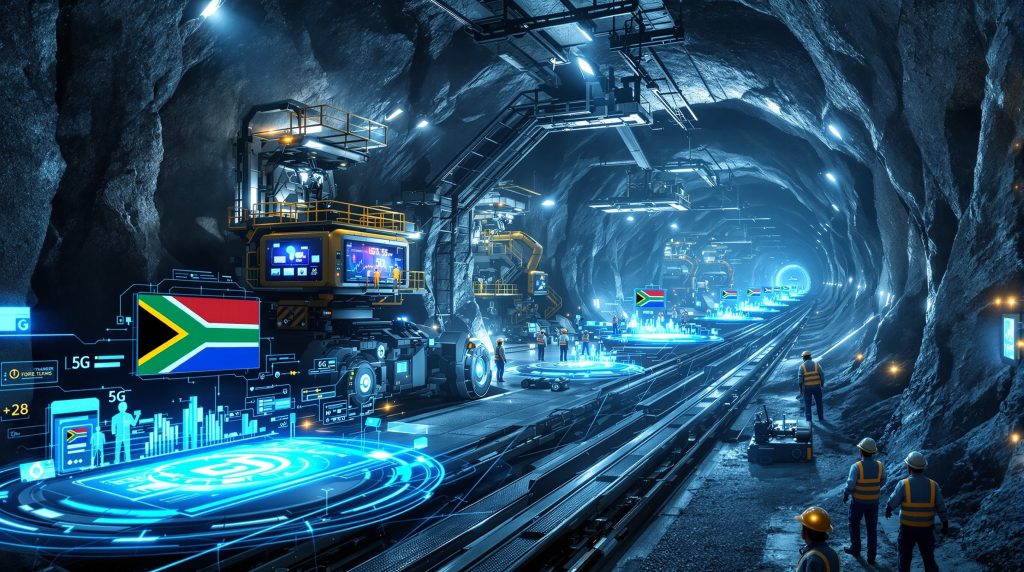What is Underground Trial Mining and Why is it Critical for South Africa?
Underground trial mining represents a crucial phase in mine development where companies test extraction methods, equipment performance, and geological assumptions before committing to full-scale operations. In South Africa, this approach has become increasingly important as surface deposits deplete and mining companies look deeper underground to access the country's vast mineral wealth.
Trial mining provides several key advantages:
- Validates economic viability with minimal capital risk
- Tests mining methods in real-world conditions
- Confirms geological models and ore grade assumptions
- Evaluates safety protocols and environmental impacts
- Trains workforce on new technologies and methods
For South Africa's mining sector, which contributes approximately 8.1% to GDP and employs over 454,000 people according to the Minerals Council South Africa, successful underground trial mining in South Africa represents a critical pathway to sustaining the industry's economic contribution while addressing unique geological and operational challenges.
The significance of trial mining extends beyond technical validation—it serves as a critical risk management tool in an industry where capital investments often reach billions of dollars. By testing extraction methodologies and geological assumptions on a limited scale, companies can make data-driven decisions before full deployment of resources.
The Strategic Value of Underground Trials
For mining executives, trial mining provides an invaluable opportunity to validate financial models against real-world conditions. As Martin Poggiolini, executive head of corporate strategy at a major platinum producer, notes, this phased approach allows companies to "truck the first ore out of the top part of the ore body to the surface" before committing to larger-scale development.
This strategy proves particularly valuable in South Africa's complex mining environment, where geological surprises can dramatically impact project economics. By establishing smaller-scale operations first, companies can refine their understanding of ore body characteristics, optimize extraction techniques, and calibrate processing parameters—all before committing to substantial capital expenditures.
How is South Africa's Underground Mining Landscape Evolving?
South Africa's underground mining sector is undergoing significant transformation, driven by both necessity and technological advancement. The country's mining history spans over 150 years, with some operations reaching extreme depths exceeding 4 kilometers below surface at mines like Mponeng.
The Transition from Surface to Underground Operations
As surface deposits become depleted, mining companies are increasingly focusing on underground resources. This transition presents both challenges and opportunities:
- Geological Complexity: South Africa's underground deposits often feature complex geological structures requiring specialized mining approaches
- Depth Challenges: Operations at extreme depths face issues with rock pressure, heat, and logistical complexity
- Economic Pressures: Higher operating costs underground necessitate greater efficiency and technological innovation
- Safety Imperatives: Deep underground environments present unique safety challenges requiring advanced monitoring and protection systems
The evolution toward deeper operations has catalyzed significant investment in trial mining programs designed to validate new approaches before full-scale implementation. This progression represents not merely a technical shift but a fundamental reimagining of how mining operations are conceived and executed in the South African context.
Regulatory and Economic Framework
South Africa's mining regulatory environment has evolved to support responsible underground development through:
- Comprehensive feasibility study requirements including trial mining phases
- Enhanced safety standards for underground operations
- Community engagement mandates ensuring social license to operate
- Environmental stewardship requirements throughout the mining lifecycle
These regulatory developments, combined with favorable market conditions for platinum group metals, gold, and other minerals, have created conducive conditions for underground trial mining investments despite South Africa's broader economic challenges.
The Mining Charter and associated regulations have established clear pathways for companies pursuing underground development, with specific provisions addressing trial mining operations. These frameworks balance the need for economic development with social and environmental responsibilities, creating a structured approach to underground resource development.
What Makes Platinum Group Metals Development in Limpopo Significant?
The Limpopo province has emerged as the epicenter of South Africa's most ambitious underground trial mining developments, particularly in the platinum group metals (PGM) sector. This region's exceptional geological endowment has attracted significant investment in sophisticated underground projects.
The Sandsloot Underground Project: A Case Study in Modern Trial Mining
The Sandsloot underground project represents a flagship example of modern underground trial mining in Limpopo. This project demonstrates several key innovations:
- Strategic Transition: The project marks a shift from open-pit to underground mining methodologies
- Superior Ore Grades: Trial mining targets reef grades of 4-6 grams per ton, significantly higher than comparable operations
- Favorable Geology: The project benefits from competent hanging wall and approximately 45-meter reef height
- Phased Development: Implementation follows a graduated approach allowing progressive derisking
The project plans to implement a tracking solution supporting an initial production rate of approximately 2-2.5 million tons annually, with potential expansion to 3.6-4.5 million tons annually beyond 2030 if initial phases meet capital allocation criteria. This phased approach reflects a strategic balance between opportunity and risk management.
According to industry analysts, the Mogalakwena mine complex in Limpopo—which includes the Sandsloot pit—currently contributes approximately 50% of its owner's PGM production, highlighting the strategic importance of this development. The underground expansion represents a significant vote of confidence in the long-term fundamentals of the PGM sector.
Mechanized Mining Methods Under Evaluation
Trial mining operations in Limpopo are evaluating various mechanized mining methods, each offering distinct advantages:
| Mining Method | Key Advantages | Application Context |
|---|---|---|
| Longhole Open Stoping | High productivity, good recovery | Competent rock, wider orebodies |
| Room and Pillar | Flexible, selective mining | Tabular deposits, moderate depth |
| Cut and Fill | High recovery, ground control | Variable grade deposits |
| Drift and Fill | Adaptable to changing conditions | Complex orebodies |
| Mechanized Bench Mining | High production rates | Massive deposits |
These mechanized approaches offer significant advantages over conventional methods, including:
- Worker productivity rates typically 3-5 times higher than conventional mining
- Reduced exposure of personnel to high-risk underground environments
- More consistent production outputs
- Better adaptation to changing ground conditions
- Enhanced ventilation management through reduced workforce requirements
The selection of optimal mining methods through trial mining allows for data-driven decision-making, ensuring that full-scale operations can implement the most effective approach for specific geological conditions.
How Are Automation and Robotics Transforming Underground Trial Mining?
The integration of advanced automation in mining technologies and robotics systems represents one of the most significant developments in South African underground trial mining, fundamentally transforming operational approaches and safety protocols.
The Automation Revolution in South African Mines
Automation technologies have progressed from experimental phases to become integral components of modern underground operations:
- Autonomous Fleets: Some South African mines have operated fully automated, remote-controlled truck fleets for over a decade
- Intelligent Machines: Mining equipment manufacturers have developed "intelligent" mining machines capable of operating independently within access-controlled safety zones
- Digital Ecosystems: Comprehensive digital monitoring systems provide real-time operational data for analysis and optimization
- Remote Operations: Control rooms on surface enable remote operation of underground equipment, reducing human exposure to hazardous environments
The progression from manual to automated operations involves multiple technological layers working in coordination, creating what industry experts term the "digitalization of mining." This transformation fundamentally changes the skills required for mining operations, creating new opportunities for technical specialists while reducing the number of workers exposed to underground hazards.
5G Technology: Enabling Next-Generation Underground Connectivity
The implementation of 5G technology in underground mining operations represents another major advancement reshaping trial mining approaches:
- Enhanced Connectivity: 5G's high bandwidth and low latency capabilities offer superior alternatives to conventional optical fiber networks
- Comprehensive Data Transfer: The technology enables transfer of data from scanners, sensors, and cameras for above-ground analysis
- Private Networks: Mine operators are investing in private 5G networks, gaining advanced connectivity through infrastructure they own and control
- Return on Investment: Research indicates applications enabled by private cellular networks offer a 256% return on investment in under ten years for underground mines
Featured Insight: According to mining technology experts, applications enabled by private cellular networks—including remote drilling, autonomous vehicles, and real-time condition monitoring—deliver substantial operational improvements while significantly reducing safety risks.
These connectivity advancements are particularly valuable in trial mining contexts, where comprehensive data collection and analysis are essential for validating new approaches. The ability to monitor operations in real-time from surface allows for rapid adjustments and optimization, accelerating the learning process.
What Safety Innovations Are Being Deployed in Underground Trial Mining?
Safety technology development represents a critical focus area for South African underground trial mining, with numerous innovations addressing the unique challenges of deep-level operations.
Robotic Systems for High-Risk Environments
Advanced robotic platforms are transforming safety management in underground environments:
- Inspection Robots: Systems like the "Monster" robot platform can enter mines during particularly dangerous periods to assess conditions without human exposure
- Low-Profile Robots: Electric robotic systems standing just 65 cm tall can access extremely confined spaces and operate on slopes up to 22 degrees
- Collaborative Robots: Research focuses on developing robots that can intuitively gauge human intent and work alongside miners in complex environments
These robotic systems fundamentally shift risk management from human exposure to technology-mediated assessment, dramatically improving safety outcomes. By deploying robots in high-risk scenarios, mining companies can gather critical information without endangering personnel, enabling more informed decision-making.
Advanced Monitoring and Early Warning Systems
Sophisticated monitoring technologies provide unprecedented visibility into underground conditions:
- RockPulse: This early-warning system continuously observes rock masses for small seismic activity, providing advance warning of potential rockfall events
- Ground Penetration Radar: GPR technology enables miners to visualize potentially hazardous geological structures in the hanging wall before they become dangerous
- Collision Prevention Systems: Advanced technologies address the challenges of integrating autonomous and human-operated vehicles in underground environments
These monitoring systems enable proactive safety management rather than reactive response to emergencies, fundamentally changing how risk is managed in underground operations. The integration of these technologies into trial mining operations allows for comprehensive safety validation before full-scale deployment.
Environmental Monitoring and Management
Modern trial mining operations incorporate comprehensive environmental monitoring systems:
- Air Quality Sensors: Real-time monitoring of gases, particulates, and other atmospheric conditions
- Water Management Systems: Continuous tracking of water quality and quantity throughout mining operations
- Ventilation Optimization: Advanced systems that adjust airflow based on real-time operational needs and environmental conditions
These environmental technologies not only improve worker safety but also support regulatory compliance and sustainable mining practices. By incorporating comprehensive environmental monitoring into trial mining, companies can validate their environmental management strategies before scaling to full production.
What Challenges Do Deep-Level Mining Operations Face?
South Africa's position as home to some of the world's deepest mines presents unique challenges requiring specialized trial mining approaches and innovative solutions.
Technical Challenges of Extreme Depth
Operations at depths exceeding 3 kilometers face unprecedented technical challenges:
- Rock Pressure Management: Extreme in-situ stresses require sophisticated destressing methods and ground support systems
- Heat Management: Rock temperatures can exceed 60°C at depth, requiring extensive cooling infrastructure
- Logistics Complexity: Moving personnel, equipment, and ore through deep shafts presents significant operational challenges
- Water Management: Deep operations often encounter substantial groundwater requiring sophisticated pumping and treatment systems
These technical challenges necessitate extensive trial mining programs to validate solutions before full-scale implementation. The extreme conditions at depth require specialized approaches that can only be validated through real-world testing on a limited scale before committing to larger investments.
Case Study: Mining Method Evolution at South Deep
The South Deep mine exemplifies the complex challenges and innovative solutions associated with deep-level mechanized mining:
- Currently operating between 2,600 and 3,000 meters below surface
- Expected to reach 3,400 meters depth as operations progress
- Has implemented multiple mining method changes to address unique challenges
- Evolved from conventional destressing to sophisticated mechanized approaches
The mine's journey demonstrates how trial mining enables progressive refinement of methods based on actual operating experience and changing ground conditions. This evolutionary approach has allowed South Deep to address complex technical challenges through iterative improvement rather than single-stage implementation.
Economic Viability Challenges
Deep-level operations face significant economic challenges that trial mining helps address:
- Capital Intensity: Deep mines require substantial upfront investment in infrastructure
- Operating Costs: Energy, cooling, and maintenance costs increase dramatically with depth
- Production Ramp-Up: Achieving targeted production rates often takes longer than anticipated
- Method Optimization: Finding the optimal balance between production rate, recovery, and cost requires extensive trial mining
Successful trial mining programs help quantify these challenges and develop strategies to ensure economic viability despite the inherent difficulties of deep-level operations. By validating economic assumptions on a smaller scale, companies can make informed decisions about full-scale development.
How Does Illegal Mining Impact South Africa's Underground Sector?
While legal underground trial mining represents the progressive face of South Africa's mining industry, the country continues to grapple with a massive illegal underground mining crisis that has reached tragic proportions.
The Scale and Impact of Illegal Underground Mining
Illegal mining operations have created significant challenges across South Africa's mining regions:
- An estimated 6,100 disused mines where illegal mining activities occur
- Annual economic losses exceeding $3 billion according to government estimates
- Sophisticated criminal networks controlling illegal mining value chains
- Widespread environmental damage and infrastructure destruction
- Violent conflict between rival mining groups
These illegal operations operate parallel to legitimate mining activities, creating complex security and social challenges for the formal mining sector. The scale of illegal mining represents a significant drain on national resources while creating safety and security risks across mining regions.
The Human Tragedy of Illegal Mining
Recent incidents have highlighted the desperate and dangerous nature of illegal mining:
- Hundreds of miners trapped underground for months after police operations
- Dozens of confirmed deaths from starvation, dehydration, and illness
- Miners risking their lives for promised earnings of approximately $5,300 for a few weeks of work
- Extreme underground conditions without proper safety equipment or protocols
These tragic situations reflect broader socioeconomic challenges, with high unemployment and economic inequality driving individuals to risk their lives in abandoned underground workings. The humanitarian crises associated with illegal mining create complex ethical and practical challenges for the industry and government.
Government Response and Industry Impact
The response to illegal mining involves complex interactions between economic, law enforcement, and human rights considerations:
- Increased security measures around active and abandoned mining sites
- Investigation of entire illegal mining value chains
- Debate over responsibility for humanitarian outcomes
- Pressure on legitimate mining companies to secure abandoned operations
The illegal mining crisis presents significant reputational challenges for South Africa's mining sector while complicating efforts to promote legitimate underground mining development. Addressing this challenge requires coordinated efforts between industry, government, and communities to create sustainable alternatives while enforcing legal frameworks.
What Does the Future Hold for Underground Trial Mining in South Africa?
The future of underground trial mining in South Africa appears promising despite significant challenges, with technological innovation and strategic development creating new opportunities for sustainable growth.
Technological Frontiers
Emerging technologies are poised to transform underground mining operations:
- Artificial Intelligence: Machine learning algorithms optimizing everything from ventilation to ore sorting
- Virtual Reality: Immersive training environments reducing accidents and improving operational efficiency
- Battery Electric Vehicles: Zero-emission underground equipment improving air quality and reducing ventilation requirements
- Advanced Automation: Fully autonomous mining systems operating in the most challenging environments
These technological frontiers represent areas where South African mining companies are actively conducting trial mining to validate implementation approaches and quantify benefits. The integration of these technologies into underground operations has the potential to transform safety, efficiency, and environmental performance.
Economic Outlook and Investment Landscape
The economic outlook for underground trial mining reflects both challenges and opportunities:
- Strong global demand for platinum group metals supporting investment in new underground developments
- Rising energy costs driving innovation in energy-efficient mining methods
- Increasing investor focus on ESG performance incentivizing sustainable mining practices
- Growing recognition of South Africa's strategic mineral resources in global supply chains
These economic factors create favorable conditions for continued investment in underground trial mining, particularly in the platinum group metals sector. As Agit Singh, head of processing operations at a major platinum producer, notes, there is "really good confidence in the fundamentals around the PGM sector in the short term and certainly in the longer term," citing emerging demand from hydrogen production and fuel-cell electric vehicles.
Sustainability and Community Integration
Future underground trial mining will increasingly focus on sustainability and community integration:
- Water-efficient mining technologies minimizing environmental impact
- Energy optimization reducing carbon footprint
- Skills development programs creating sustainable employment opportunities
- Community ownership models ensuring equitable benefit distribution
These sustainability initiatives represent not just ethical imperatives but strategic necessities for securing social license to operate and attracting investment. As mining companies look to develop underground resources, they must balance economic, environmental, and social considerations to ensure long-term viability.
Conclusion: The Transformative Potential of Underground Trial Mining
Underground trial mining in South Africa stands at a critical juncture, with technological innovation, economic necessity, and sustainability imperatives converging to create unprecedented opportunities for transformation. The sector's evolution from conventional labor-intensive methods toward highly mechanized, automated operations represents not just an operational shift but a fundamental reimagining of how underground mining can be conducted safely, efficiently, and responsibly.
The platinum group metals sector in Limpopo exemplifies this transformative potential, with projects like Sandsloot demonstrating how sophisticated trial mining programs can validate new approaches while minimizing capital risk. These developments, combined with advances in robotics, automation, and safety technologies, position South Africa's underground mining sector for sustainable growth despite the challenges of extreme depth, complex geology, and socioeconomic pressures.
The contrast between legitimate trial mining developments and illegal mining operations highlights the importance of responsible industry leadership and effective governance. By addressing both the technical challenges of underground mining and the broader socioeconomic factors that drive illegal activities, South Africa has the opportunity to develop an underground mining sector that creates sustainable value while protecting human life and environmental integrity.
As the country continues to navigate this complex transition, mining industry evolution will remain an essential component for validating new approaches, managing risk, and ensuring that South Africa's mineral wealth contributes positively to national development for generations to come. Furthermore, opportunities for mineral beneficiation in South Africa present additional economic potential beyond extraction activities, creating a more comprehensive value chain within the country.
The successful implementation of underground trial mining will depend not only on technological innovation but also on effective interpretation of operational data. Companies that excel at drill results interpretation will be better positioned to optimize their underground operations and maximize resource recovery while maintaining safe working conditions.
Further Exploration:
Readers interested in learning more about underground mining developments in South Africa can also explore related educational content from Mining.com, which offers perspectives on global mining trends and technological innovations in the sector.
Want to Stay Ahead of the Next Major Mining Discovery?
Discover why significant mineral discoveries can lead to substantial market returns by exploring Discovery Alert's dedicated discoveries page, where our proprietary Discovery IQ model delivers real-time alerts on ASX announcements to give investors a crucial market advantage. Begin your 30-day free trial today at https://discoveryalert.com.au/discoveries/ and position yourself ahead of the market.




